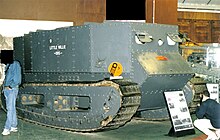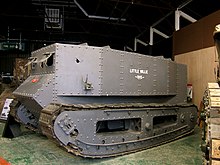Little Willie
Little Willie was a prototype of tank development and the first usable tank in military history .
Number 1 Lincoln Machine
In the early summer of 1915, the Landships Committee , chaired by Winston Churchill, began developing an armored vehicle that would meet the British military's desire for a fighting vehicle with a trench crossing capability of 5 feet (1.50 meters). With the help of these landships , the positional warfare in Flanders was to be transformed into a war of movement . After several attempts with different chain and drive equipment had failed (the Killen-Strait Tractor with three chains were tested, among other things) , Sir William Tritton became the director of the agricultural machinery factory "William Foster & Co. Ltd" in Lincoln on July 29, 1915 , commissioned a so-called "Tritton Machine" with two caterpillar tracks. The concept came from his chief developer William Rigby. In contrast to the previously made models, the chains were to be longer (seven instead of four rollers), and the suspension should also be improved. The used chassis from a tractor from the Bullock Creeping Grip Tractor Company ( Chicago ) was used.
Work began on August 11, 1915, and on August 16, Tritton added two trailing wheels with a diameter of 1.37 meters to improve control. (The wheels, however, were only sufficient to steer slight curves, otherwise the brakes had to be worked on.) On September 9th, the Number 1 Lincoln Machine - as its official name - made its first test run on the grounds of the Wellington Foundry. It quickly became clear that the flat chain guide during steering maneuvers would lead to the greatest hindrances due to the dragged-off ground mass. After solving this problem with a different chassis variant, the next difficulties arose. When crossing trenches, the chains sagged and jammed in the guide of the running wheels. Tritton and Lieutenant Walter Gordon Wilson tried all kinds of alternative drive types, initially without success. On September 22nd, they managed to keep the chains on the drive by using cast chain links with integrated center guide teeth. The drive frame was attached to the tub with large spring-loaded spindles, but this allowed only minimal spring travel. This system, although speed limiting, was used on all British tanks up to the Mark VIII .
description
Most of the mechanical components came from the Foster-Daimler artillery tractor . The 105 hp Daimler engine housed in the rear received its fuel from two tanks above it by means of gravity. Below the non-rotating tower, in which a machine gun was initially housed, there was just enough room for the crew in front of the engine. The tower's machine gun was later replaced by a Vickers 2-pounder cannon . Secondary armament was then up to six Madsen machine guns (original ideas from Tritton were to make the turret movable on rails and to move it forward if necessary). 800 rounds of ammunition were carried for the cannon . The two drivers sat in the front of the vehicle, one operated the steering wheel, the clutch , the front gearbox and the accelerator lever, the other the brakes, which were also used for steering movements. Two more men were needed to operate the rear gear, two more to handle the cannon, so that a minimum crew of six men was always required, who should also shoot with the six machine guns in addition to the cannon. The maximum speed was limited to 2 miles (approx. 3.4 km / h) per hour. The material of the shell was not made of armored steel, but of steam boiler plates with a thickness of only 10 millimeters, which were riveted to a box-shaped frame made of angle iron. The “steering wheels” sat on a subframe that was connected to the rear of the vehicle. The wheels, which sat in hinges that could be moved laterally, could be moved across the direction of travel by means of a cable pull. This then possibly resulted in the hoped-for tax effect. In the beginning there was the undesirable side effect that the outer chain did not follow the movement, jumped off and ran straight on.
Conclusion
Dissatisfied with the basic concept of the Number 1 Lincoln Machine , Wilson started thinking about improvements in August and began building a successor model on September 17th. This second prototype was the Mark I (called "His Majesty's Land Ship" HMLS Centipede or Mother .)
The Number 1 Lincoln Machine has been improved even further. However, since the Mark I had proven to be suitable for the front, no further possibilities were seen here and work on the Little Willie stopped in December.
Although never in combat use, Little Willie was a major step in military technology as the first prototype tank to be made ready to drive, and can rightly be called the ancestor of the main battle tank (the prototype of the French Schneider CA1 tank became started in January 1915, but it was not finished until February 1916).
The name Little Willie came from the British tabloid press who wanted to use it to meet the German Crown Prince Wilhelm .
Current
Little Willie was saved from scrapping in 1940 and is now in the Bovington Tank Museum . Only the shell is left.
Technical specifications
| Start of development | July 1915 |
| Production section | August – September, 1915 |
| Classification number | 1 |
| Length without tail wheels | 5.45 meters |
| width | 2.80 meters |
| Height including tower | 3.05 meters |
| Height without tower (after conversion) | 2.41 meters |
| Weight | 18,289 t |
| suspension | unavailable |
| Speed road | 2 mph (3.4 km / h) max. |
| Speed terrain | approx. 0.7 mph (1 km / h) |
| Range | ? km |
| Trench crossing ability | 1.20 meters (later improved to: 1.50 meters) |
| Climbing ability | 0.30 meters (later improved to: 0.60 meters) |
| Climbing ability | 30% |
| Main armament | Vickers 2-pounder cannon |
| Secondary armament | 6 Madsen machine guns |
| Armor | approx. 10 mm |
| Engine | Foster-Daimler 6-cylinder water-cooled gasoline in-line engine |
| Engine power | 105 PS (78 kW) |
| team | 6th |
| Performance ratio | 6 hp / t |
swell
- Christopher F. Foss among other things: tanks and other combat vehicles 1916 until today. A technical reference work on the combat vehicles from World War I to the present day. Buch- und Zeit-Verlagsgesellschaft, Cologne 1978.
- English Wikipedia


